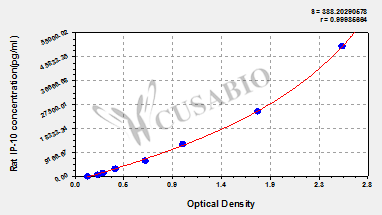Chemokine (C-X-C motif) ligand 10 (CXCL10), also known as interferon-inducible protein 10 (IP-10), is a small cytokine belonging to the CXC chemokine family. This protein attracts and activates immune cells, particularly T cells, monocytes, and natural killer cells. Interferon-gamma primarily induces CXCL10, which participates in inflammatory processes, antimicrobial responses, and tissue repair mechanisms. Its expression increases during infections, autoimmune diseases, and various pathological conditions, making it a valuable biomarker for studying immune system activation and inflammatory responses in research settings.
The Rat interferon-inducible protein 10,IP-10 ELISA Kit (CSB-E08182r) is designed for quantitative measurement of CXCL10 in Rattus norvegicus samples. This sandwich ELISA works with serum, plasma, and tissue homogenates with a detection range of 781.25 pg/mL to 50000 pg/mL and sensitivity of 195 pg/mL. The assay requires 50-100 μL sample volume and can be completed within 1-5 hours. Detection occurs at 450 nm wavelength, providing researchers with a reliable tool for measuring rat CXCL10 levels in various biological samples.
Application Examples
Note: The following application examples are drawn from a selection of publications citing this product. For additional applications, please refer to the full list of references in the "Citations" section.
This ELISA kit has been used in research examining inflammatory responses and immune system activation across multiple tissue types and biological fluids. Studies have applied the kit to quantify chemokine levels in both central nervous system tissues and systemic circulation, supporting research into neuroinflammation and peripheral immune responses. The kit has also been used in musculoskeletal research examining inflammatory mediators in joint-related pathologies.
• Neuroinflammation research: Measurement of chemokine production in brain tissue homogenates and plasma to evaluate central nervous system inflammatory responses
• Systemic inflammation studies: Analysis of serum chemokine levels alongside other pro-inflammatory cytokines and immune mediators in comprehensive immunological studies
• Musculoskeletal research: Quantification of inflammatory mediators in both serum and articular synovial fluid to examine joint-related inflammatory processes
• Multi-biomarker profiling: Integration with panels measuring various cytokines, growth factors, and inflammatory markers to provide comprehensive immune system characterization






